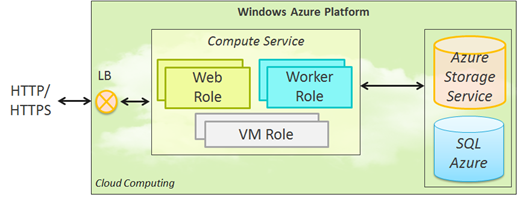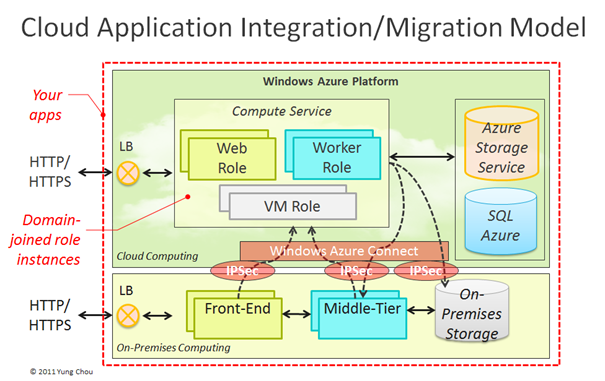Cloud Computing in PaaS with Windows Azure Connect (Part 2/2)
- Part 1: Concept
- Part 2: Application Integration/Migration Model
With the introduction of Windows Azure Connect, many options for an on-premises application to integrate with or migrate to cloud at an infrastructure level are  available. The integration and migration opportunities will become apparent by examining how applications are architected for on-premises and cloud deployments. These concepts are profoundly important for IT pros to clearly identify, define, and apply while expanding the role and responsibilities into a cloud or service architect. In Part 2, let’s first review computing models before making cloud computing a much more exciting technical expedition with Windows Azure Connect.
available. The integration and migration opportunities will become apparent by examining how applications are architected for on-premises and cloud deployments. These concepts are profoundly important for IT pros to clearly identify, define, and apply while expanding the role and responsibilities into a cloud or service architect. In Part 2, let’s first review computing models before making cloud computing a much more exciting technical expedition with Windows Azure Connect.
Then Traditional 3-Tier Application Architecture
Based on a client-server model, the traditional n-tier application architecture carries out a business process in a distributed fashion. For instance, a typical 3-tier web application as shown below includes:
- Front-end which is the web site exposed to an intended interface, either a public endpoint or an internal URL, for processing incoming HTTP/HTTPS requests
- Middle-Tier to hold business logic and secure connection to required resources
- Back-end, data stores

When deployed on premises, IT has physical access the entire infrastructure and is responsible for all aspects in the lifecycle including configuration, deployment, security, management, and disposition of resources. This had been a deployment model upon which theories, methodologies, and practices have been developed and many IT shops operated. IT controls all resources and at the same time is responsible for the end-to-end and distributed runtime environment of an application. Frequently, to manage an expected high volume of incoming requests, load-balancers which are expensive to acquire and expensive to maintain are put in place associated with the front-end of an application. To improve data integrity, clusters which are expensive to acquire and, yes, expensive to maintain are configured at the back-end. Not only load-balancer and clusters increase the complexities and are technically challenging with skillsets hard to acquire, but both fundamentally increase the capital expenses and the operational costs throughout the lifecycle of a solution and ultimately the TCO.
Now State-of-the-Art Windows Azure Computing Model
Windows Azure Platform is Microsoft’s Platform as a Service, i.e. PaaS solution. And PaaS here means that an application developed with Windows Azure Platform (which is hosted in data centers by Microsoft around the world) is by default delivered with Software as a Service, or SaaS. A quick review of the 6-part Cloud Computing for IT Pros series, one will notice that I have already explained the computing concept of Windows Azure (essentially Microsoft's cloud OS) in Computing Model and Fabric Controller. Considering Windows Azure computing model, Web Role is to receive and process incoming HTTP/HTTPS requests from a configured public endpoint, i.e. a web front-end with an internet-facing URL specified during publishing an application to Windows Azure. A Web Role instance is deployed to a (Windows Server 2008 R2) virtual machine with IIS. And the Web Role’s instances of an application are automatically load-balanced by Windows Azure. On the other hand, Worker Role is like a Windows service or batch job, which starts by itself and is the equivalent middle-tier where business logic and back-end connectivity stay in a traditional 3-tier design. And a Worker Role instance is deployed with a virtual machine without IIS in place. The following schematic illustrates the conceptual model.

VM Role is a definition allowing a virtual machine (i.e. VHD file) to be uploaded and run with Windows Azure Compute service. There are some interesting points of VM Role. Supposedly based on separation of responsibilities, in PaaS only Data and Application layers are managed by consumers/subscribers while Runtime layer and below are controlled by a service provider which in the case of Windows Azure Platform is Microsoft. Nevertheless, VM Role in fact allows not only Data and Application, but also Runtime, Middleware, and OS layers all accessible in a virtual machine controlled by a subscriber of Windows Azure Platform which is by the way a PaaS and not IaaS offering. This is because VM Role is designed for addressing specific issues, and above all IT pros need to recognized that it is intended as a last resort. Information of why to employ VM Role and how is readily available elsewhere, and not repeated here.
So, with Windows Azure Platform, the 3-tier design is in fact very much applicable. The Windows Azure design pattern employs Web Role as a front-end to process incoming requests as quickly as possible, while Worker Role as a middle-tier to do most of the heavy lifting, namely execute business logic against application data. The communications between Web Role and Worker Role is with Windows Azure Queue and detailed elsewhere.
With Visual Studio and Windows Azure SDK, the process of developing a Windows Azure application is highly transparent to that of an on-premise application. And the steps to publish a Visual Studio cloud project are amazingly simple to simply uploading two files to Windows Azure Platform Management Portal. The two files are generated when publishing an intended cloud project in Visual Studio. They are a zipped package of application code and a configuration file with cspkg and cscfg file extensions, respectively. The publishing process can be further hardened with certificate for higher security.
Compared with on-premises computing, there are noticeable constraints when deploying application to cloud including:
- An application must be stateless. And client-specific state information must be passed back to an associated client or store in durable storage, i.e. Windows Azure storage or SQL Azure. For an on-premise application relying a sticky session, cloud computing may present a need to re-architect data management of the application.
- The ability for an application to self-initialize, i.e. proceed with installation and program-start without operator intervention, is imperative.
These constraints are related to enabling system management of resource pooling and elasticity which are part of the essential characteristics of cloud computing.
Two important features, high availability and fault tolerance, are automatically provided by Windows Azure. Which can significantly reduce the TCO of an application deployed to cloud compared with that of an on-premises deployment. Here, details of how Windows Azure achieves automatic high availability and fault tolerance are not included. A discussion of this topic is already scheduled to be published in my upcoming blog post. Stay tuned.
An Emerging Application Architecture
With Windows Azure Connect, to integrate and extend a 3-tire on-premises deployment to cloud is now relatively easy to do. As part of Microsoft PaaS offering, Windows Azure Connect automatically configures IPSec connectivity to securely connect Windows Azure role instances with on-premises resources, as indicated by the dotted lines in the following schematic. Notice that those role instances and on-premises computers to be connected are first grouped. And all members in a group are exposed as a whole and at the group level the connectivity is established. With IPSec in place, a Windows Azure role instance can join and be part of an Active Directory in private network. Namely, server and domain isolation with Windows Authentication and group polices can now be applied to cloud computing resources without significant changes of the underlying application architecture. In other words, Windows security model and system management in a managed environment can now seamlessly include cloud resources, which essentially makes many IT practices and solutions directly applicable to cloud with minimal changes.

With the introduction of cloud computing, an emerging application architecture is a hybrid model with a combination of components deployed to cloud and on-premises. With Windows Azure Connect, cloud computing can simply be par of and does not necessarily encompass an entire application architecture. This allows IT to take advantages of what Windows Azure Platform is offering like automatic load balancing and high availability by migrating selected resources to cloud, as indicated with the dotted lines in the above schematic, while managing all resources of an application with consistent security model and domain policies. Either the front-end of an application is in cloud or on premises, the middle-tier and the back-end can be a combination of resources with cloud computing and on-premises deployment.
 Start Now and Be What’s The Next
Start Now and Be What’s The Next
With Windows Azure Connect, both cloud and on-premises resources are within reach to each other. For IT pros, this reveals a strategic and urgent need to convert existing on-premise computing into a cloud-ready and cloud-friendly environment. This means, if not already, to start building hardware and software inventories, automating and optimizing existing procedures and operations, standardizing authentication provider, implementing PKI, providing federated identity, etc. The technologies are all here already and solutions readily available. For those feeling Windows Azure Platform is foreign and remote, I highly recommend familiarizing yourselves with Windows Azure before everybody else does. Use the promotion code, DPEA01 to get a free Azure Pass without credit card information. And make the first step of upgrading your skills with cloud computing and welcome the exciting opportunities presented to you.
Having an option to get the best of both cloud computing and on-premises deployment and not forced to choose one or the other is a great feeling. It’s like… dancing down the street with a cloud at your feet. And I say that’s amore.
<Back to Part 1: Concept>